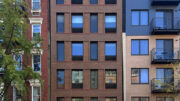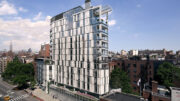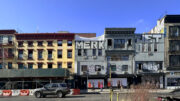606 Broadway, on the corner of Houston Street, is nearly complete. The narrow, triangular-shaped building is composed of a steel structure rising six stories above SoHo. It is being designed by S9 Architects and developed by Madison Capital Realty. When finished, 606 Broadway will have 34,300 square feet of interior space with 22,500 square feet allocated for future office space.
Looking at recent progress of the new office building, its design remains close to early renderings. The top office floor will come with a private outdoor terrace overlooking Houston Street. This is why the main elevation features a central void in the middle of the sixth floor. The glass curtain wall is basically complete while work on the ground level exterior wraps up. Across the main northern elevation, dark-colored masonry is sandwiched between the large floor-to-ceiling glass windows in a staggered pattern.
Three floors of retail space is set to come to the project, as well as street-level access to the Broadway-Lafayette subway station with services for the B, D, F, M and 6 trains.
Construction on 606 Broadway should finish sometime before the end of 2019.
Subscribe to YIMBY’s daily e-mail
Follow the YIMBYgram for real-time photo updates
Like YIMBY on Facebook
Follow YIMBY’s Twitter for the latest in YIMBYnew
Subscribe to YIMBY’s daily e-mail
Follow YIMBYgram for real-time photo updates
Like YIMBY on Facebook
Follow YIMBY’s Twitter for the latest in YIMBYnews







Please pardon me for using your space: I’m back to development after I have problem with handsome boys, they want my body get exercise near them. (Thanks to America’s progress)
A fine addition to the streetscape.
Landmarks voted down the first design because they deemed it out of context with the type of historic architecture in the surrounding district. A perfect reproduction of a wooden Victorian style house that might contextually fit in the Prospect Park South historic district, which is full of similar residential structures and styles, would not get approved for the SoHo or TriBecCa districts either, because the historical style for which they were landmarked is commercial and industrial. Decisions at The LPC have to balance numerous issues – especially context – in addition to pure aesthetics. Another value they balance is historical value – did an important event happen there, was an important historical figure involved with the site, does the site memorialize a lost element of NYC history. This is the basis for landmarking sites that may not appear architecturally or aesthetically special but are important historical touchstones, like the Stonewall Inn gay bar in the Village and Weeksville in Brooklyn. Currently, this is the argument forward for landmarking an otherwise architecturally undistinguished house in Wallabout where Walt Whitman
once lived and may have written parts of his poetic masterpiece.